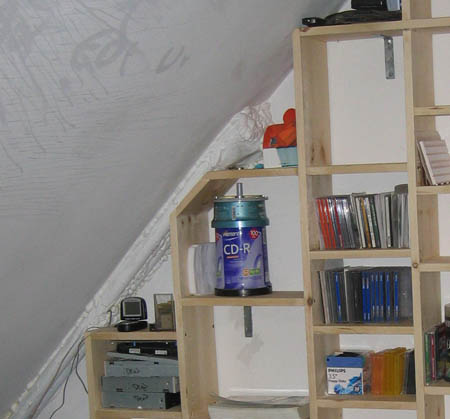|
|
|
papier mâché as a structural material
Monday, June 25 2007
setting: rural Hurley Township, Ulster County, New York
There's a spot on the laboratory's north wall where the foam-insulated solar hydronic pipes turn 90 degrees and penetrate to the outdoors, at which point the copper pipes turn into rubber roses for the climb up to the rooftop. Beneath that 90 degree turn I've constructed a shelving unit which I've been adding to over time, gradually burying the solar pipes in a soffit composed of spray foam, joint compound, and a single one by eight plank. At the actual turn, though, there's no planking to linearify the geometry and I'm forced to go freestyle. What has developed over time is a bulbous structure on the wall. For a long time it was an ugly combination of spray foam and duct tape, but recently I've been filling in the holes and trimming off the peaks to make it into a single, smooth organic form. To get that form even smoother, today I covered the bulb in a layer of papier mâché. I've kindled a vague interest in this media since I was a child and saw my mother patiently making marionettes from it. It seems infinitely flexible, and, unlike carving, easy to correct. My mother made her papier mâché using newspaper and wheat paste, but the stuff I used today consisted of Elmer's glue and torn pieces of white printer paper. In the past I've made small patches for damaged drywall using paper and wood glue. Papier mâché is amazingly strong material, particularly when it is layered over a material like dried joint compound having good compressional strength. It would be fun to use papier mâché as an interior finish to "organify" the features of an ordinary sheetrocked room.


Those pipes, back in April (top) and now.
For linking purposes this article's URL is:
http://asecular.com/blog.php?070625 feedback
previous | next |

